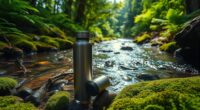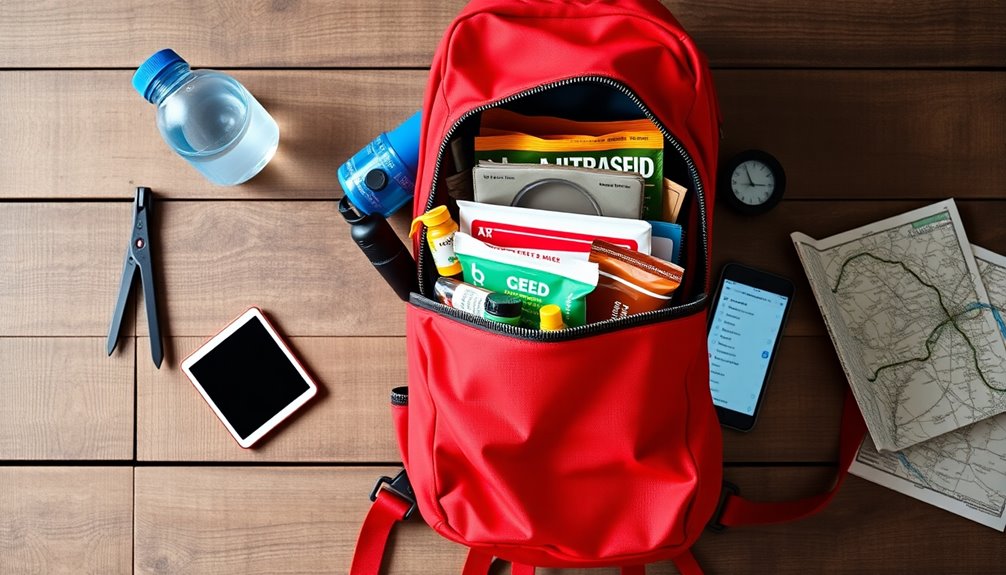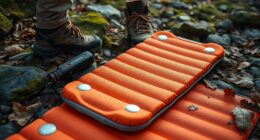Finding water at sea is vital for survival, and several techniques can help you secure it. Start by collecting rainwater using tarps or sails; just be sure to discard the first drops to remove salt. You can also absorb moisture from fabrics or harvest condensation from surfaces overnight. If you have a desalination kit, use it to convert seawater into drinkable water. Additionally, certain fish contain moisture in their organs, providing extra hydration. By mastering these techniques, you enhance your chances of survival, and there's plenty more you'll discover to keep you safe in challenging situations.
Key Takeaways
- Collect rainwater using tarps or sails, ensuring the first drops are discarded to remove salt and prevent contamination.
- Absorb moisture from plants and surfaces overnight with absorbent fabrics to supplement your water supply.
- Utilize desalination kits to convert seawater into potable water, crucial for long-term hydration needs.
- Certain fish species can provide hydration; consume their organs for additional moisture when necessary.
- Regularly practice water sourcing techniques to enhance preparedness and ensure you meet daily hydration needs.
Introduction
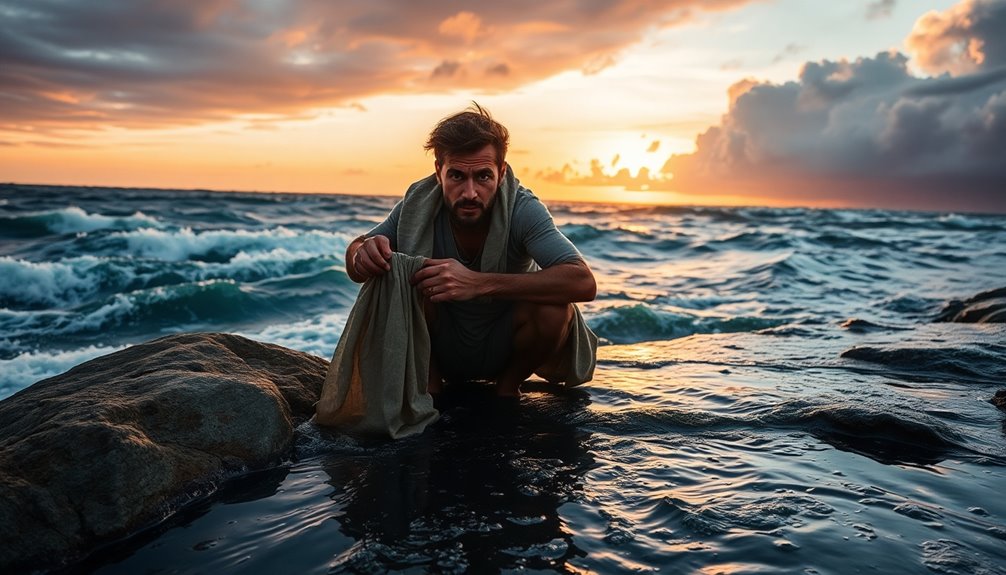
When you're stranded at sea, securing fresh water is your top priority.
Understanding key water sourcing methods can mean the difference between survival and peril.
In this article, you'll explore effective techniques for acquiring water and the goals you should aim for in a survival scenario.
Key Water Sourcing Methods
Sourcing drinkable water at sea presents unique challenges, but several effective methods can help you secure this vital resource.
Rainwater collection is one of the most efficient techniques; use tarps or sails to catch and channel rainwater into containers, discarding the initial drops to wash off salt.
Avoid drinking seawater, as its high salt content can lead to severe dehydration.
You can also employ moisture absorption techniques by wringing out damp fabric overnight into containers for fresh water.
Consider using desalination kits, which convert seawater into potable water, crucial for long-term survival.
Additionally, fishing can provide hydration, as certain fish species contain moisture in their organs that contributes to your overall water intake while employing survival techniques.
Survival Water Acquisition Goals
Acquiring fresh water during a marine survival situation is essential for your health and well-being. Your primary goal should be to collect at least 1 liter of fresh drinking water daily to prevent dehydration and maintain cognitive function.
Rainwater collection using tarps or sails is effective; make sure to catch the first drops to wash away salt. Avoid drinking saltwater, as it worsens thirst and leads to further dehydration.
Additionally, utilize condensation techniques, like collecting moisture from plants or fabric, to supplement your water supply. Desalination kits can be invaluable for converting seawater into drinkable water, ensuring long-term hydration.
Prioritizing these methods will significantly enhance your chances of survival at sea.
Water Sourcing Methods Defined

Several effective methods exist for sourcing water at sea, crucial for survival in marine environments. You can collect rainwater using tarpaulins or sails, ensuring the first drops wash away salt to obtain drinkable water.
For additional hydration, utilize fabric to absorb moisture overnight and wring it out into containers. Remember to avoid drinking seawater; its high salt content can lead to dehydration and illness.
Fishing gear not only helps catch fish for food but also provides hydration from the moisture within the fish's body. Additionally, keep an eye on wildlife behavior—animals can often lead you to nearby freshwater sources or indicate areas where moisture can be found, enhancing your survival skills and hydration sources.
Hydration's Role in Cognitive Function

When you're out at sea, staying hydrated isn't just about quenching your thirst; it's crucial for keeping your mind sharp.
Even mild dehydration can cloud your judgment and awareness of your environment, which can be dangerous in survival situations.
Cognitive Clarity During Survival
In the midst of survival situations, staying properly hydrated becomes essential for maintaining cognitive clarity. Your brain, composed of about 75% water, relies on adequate hydration to ensure optimal mental function and emotional stability.
Even mild dehydration can impair focus and decision-making, making effective water management critical during emergencies. Prolonged water scarcity leads to confusion and fatigue, significantly hindering your survival efforts.
To combat dehydration, aim for a minimum daily water intake of about 1 liter, especially when exerting yourself physically. By prioritizing hydration, you enhance your cognitive clarity, enabling better choices and increased resilience in challenging circumstances.
Environmental Awareness
Understanding your environment is crucial for survival, especially when it comes to hydration and cognitive function. Adequate hydration keeps your brain sharp, as even mild dehydration can impair focus and decision-making.
In survival at sea, you need to collect water using effective methods, ensuring it's safe to consume. Environmental awareness helps you identify sources like rainwater or condensation.
Remember, the human brain is about 75% water, so maintaining body temperature and mental clarity is vital. Dehydration can lead to confusion and fatigue, putting your survival at risk.
Utilize survival equipment to store and manage water efficiently, prioritizing hydration to support both physical endurance and cognitive performance. Your ability to make quick, rational decisions depends on staying hydrated.
Water Collection From Rain

Collecting rainwater can be a lifesaver at sea, especially during storms when every drop counts. Use a plastic tarpaulin or sails to catch rain effectively; remember to let the first drops wash away any salt to ensure safe drinking.
Always store collected rainwater in separate containers to prevent contamination from saltwater or other sources. Make sure your collection surfaces are clean to avoid introducing impurities into the water.
Additionally, consider using fabric for moisture absorption; wring it out into your containers for extra hydration. Maximizing your collection efforts during storms can significantly enhance your water supply, making rainwater a vital resource in emergencies.
Stay prepared and vigilant for every opportunity to gather this precious resource.
Essential Survival Gear

Survival at sea demands the right gear to increase your chances of making it through tough situations. Essential survival gear includes Personal Flotation Devices (PFDs) to keep you afloat and reduce heat loss in cold water.
A multi-tool is invaluable for repairs and food preparation, while reliable water purification methods, like chemical tablets or filtration systems, ensure the safety of your water supply.
Don't forget a desalination kit to convert seawater into drinkable water, which is vital for long-term survival.
An Emergency Position Indicating Radio Beacon (EPIRB) provides reliable communication during distress, alerting rescuers to your location.
Always have a survival manual on hand for guidance during critical shipboard operations, ensuring you're prepared for any scenario.
Optimizing Water Filtration Techniques

When you're out at sea, optimizing water filtration techniques is crucial for ensuring you have safe drinking water.
Start by boiling seawater for at least one minute to kill pathogens; extend this to three minutes at high altitudes. Use cloth or coffee filters to remove solid impurities from collected water, making it safer for consumption.
For effective disinfecting, consider using purification tablets like iodine or chlorine to eliminate bacteria and viruses.
You can also construct solar stills to extract moisture from soil or vegetation, utilizing evaporation and condensation.
Lastly, adding activated charcoal to filtered water not only enhances overall water quality but also improves taste and removes toxins, ensuring you stay hydrated and healthy during your marine adventure.
Dehydration Risks in Survival Situations
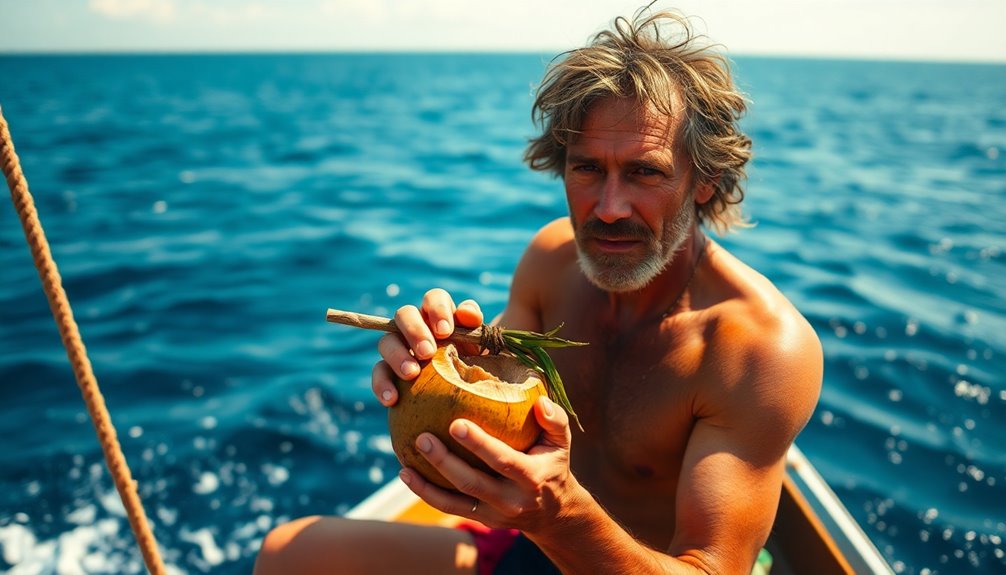
When you're in a survival situation, managing dehydration is crucial.
Utilizing efficient container usage can help maximize your water collection, while solar desalination techniques can turn seawater into a viable drinking source.
Understanding these methods not only aids in your immediate survival but also prevents the severe health risks that come with dehydration.
Solar Desalination Efficiency Tips
How can you maximize the efficiency of solar desalination in a survival situation?
First, focus on creating an optimal setup. Use dark, non-reflective surfaces to enhance heat absorption, speeding up evaporation.
Cover your desalination unit with clear plastic sheets to trap heat and create a moisture-rich environment, which boosts the production of drinkable water.
Incorporating saltwater plants like seaweed can further increase water yield during evaporation.
Always monitor the process closely to prevent contamination from your surroundings, ensuring that the collected water remains safe for consumption.
Efficient Container Usage
Efficient container usage is crucial in a survival situation, especially when dealing with the constant threat of dehydration.
Use efficient containers like plastic tarpaulins or sails for water collection, maximizing your rainwater harvest while ensuring the first drops wash away salt and contamination.
Always store your collected water in separate, clean containers to keep it safe from pollutants.
In survival situations, consider using absorbent fabrics to collect moisture and wring them out into your containers for extra drinkable water.
Remember, water conservation is essential; dehydration can set in quickly, and humans can only survive a few days without water.
Regularly inspect your containers to ensure they remain free from contamination and are ready for future use.
Survivor Stories of Water Recovery

Survivors of maritime ordeals often rely on their ingenuity to secure fresh water, a vital lifeline in challenging conditions.
Many successfully practice rainwater harvesting using improvised tarps or sails, capturing precious droplets. One survivor shared how he collected moisture overnight with fabric, wringing it out into containers for drinking—proof of resourcefulness.
Another sailor illustrated critical survival techniques by gathering condensation from plants and surfaces to supplement his dwindling supply.
Distillation methods also emerged, transforming seawater into fresh water for those in dire need.
Additionally, individuals have crafted makeshift devices from fishing gear, like nets to catch rainwater while fishing, showcasing adaptability and the relentless pursuit of hydration in desperate times.
Conclusion

Successfully securing fresh water at sea can make all the difference in a survival situation. By collecting rainwater using tarps or sails, you can obtain fresh water, ensuring the first drops wash off any salt residue.
Avoid drinking seawater, as it leads to dehydration and drastically reduces your survival chances. Instead, focus on gathering condensation from plants or fabric, which can absorb moisture from the air.
Utilizing desalination kits is also vital, as they convert seawater into drinkable water, essential for long-term survival in marine environments.
Regular practice of water collection and purification techniques will enhance your preparedness, making you more adept at securing fresh water during maritime emergencies.
Stay vigilant, and prioritize these methods to boost your odds of survival.
Additional Resources
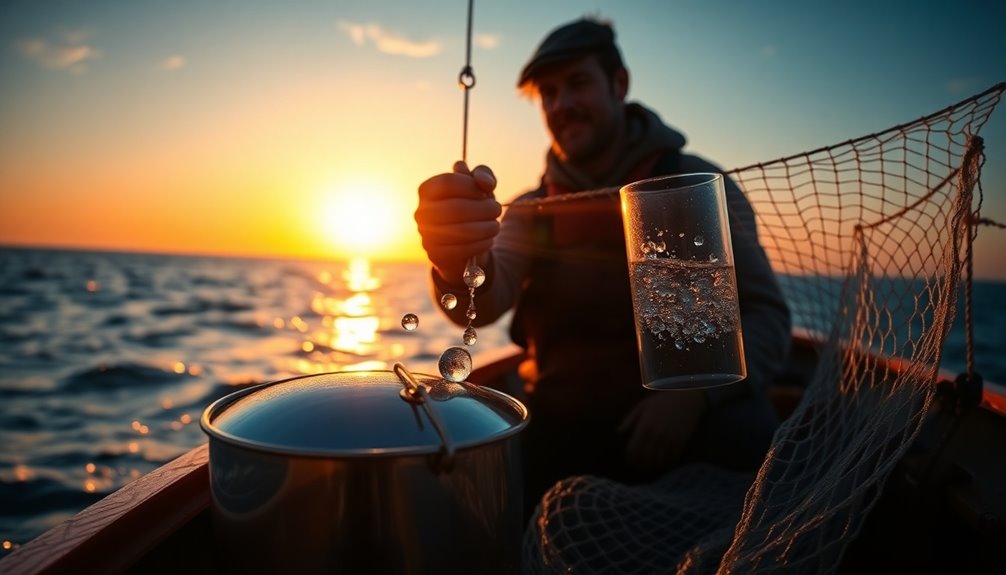
To enhance your water collection and purification efforts at sea, consider utilizing various resources tailored for maritime survival.
Rainwater collection is a highly effective method; using tarps or sails can help capture this precious resource during rainfall.
Don't forget to have desalination kits on hand—these essential tools convert seawater into potable water when fresh sources are unavailable.
Additionally, fabric can assist with moisture absorption; wring it out into containers for extra water in survival situations.
Collecting condensation from plants or fabric overnight can yield drinkable water too, just be cautious of poisonous flora.
Finally, regularly inspect and maintain your water purification methods, such as chemical tablets or filtration systems, to ensure safe consumption during maritime emergencies.
Frequently Asked Questions
What Are 3 Tips to Finding Water in a Survival Situation?
In a survival situation, you've got to be resourceful.
First, collect rainwater using tarps or any fabric you have, letting the first drops wash away contaminants.
Next, look for signs of green vegetation or animal tracks; these often indicate nearby freshwater sources.
Lastly, if you have a desalination kit, use it to convert seawater into drinkable water.
What Are the 4 Principles of Survival at Sea?
When it comes to surviving at sea, you need to remember four key principles.
First, stay afloat and minimize heat loss to prevent hypothermia.
Next, finding drinkable water is crucial; use tarps or sails to collect rainwater.
Third, signal for help using distress signals to enhance your visibility to rescuers.
Lastly, maintain mental preparedness and a positive attitude, as this will help you make rational decisions under stress and improve your chances of survival.
How to Get Fresh Water When Stranded at Sea?
When you're stranded at sea, finding fresh water is crucial. Start by collecting rainwater using tarps or sails, making sure to let the first drops wash away any salt.
Avoid drinking seawater; it'll only worsen your dehydration. You can also use fabric to absorb moisture from the air and wring it out for water.
Lastly, consider creating a solar still to turn seawater into drinkable water through evaporation and condensation.
What Are the Three Aspects in Preparation for a Sea Survival Situation?
When preparing for a sea survival situation, focus on three key aspects.
First, ensure you're mentally prepared; staying calm helps you make better decisions.
Second, regularly inspect and stock essential survival gear, like life rafts and first aid kits, so you're ready for anything.
Finally, practice emergency drills with your crew to establish clear communication and roles, ensuring everyone knows their responsibilities in a crisis.
These steps can significantly enhance your chances of survival.


